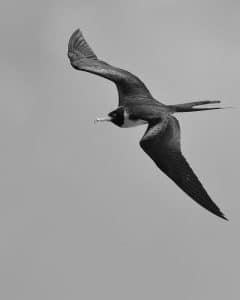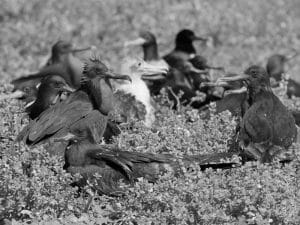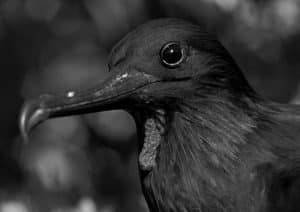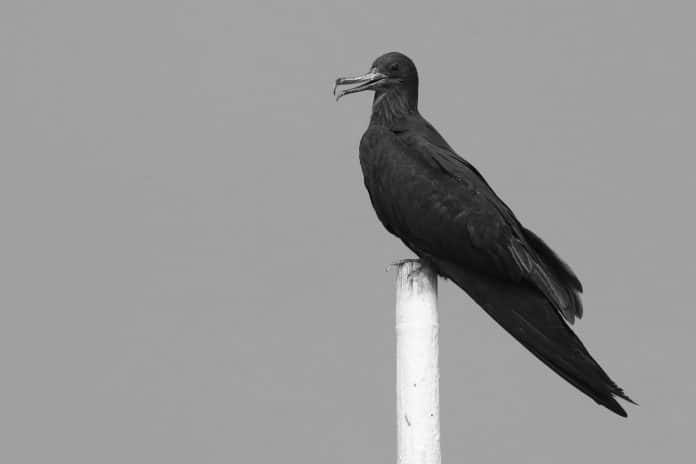Introduction to Lesser Frigatebirds
The Lesser Frigatebird is a large seabird that belongs to the Fregatidae family. The bird is characterized by its long, pointed wings, deeply forked tail, and a distinctive, hooked beak. Lesser Frigatebirds have a wingspan of up to 1.5 meters, making them one of the largest flying birds in the world. These birds are known for their impressive aerial skills, and they spend most of their life in the air, only coming to land to breed and raise their young. Lesser Frigatebirds in Tanzania are found in tropical and subtropical oceans worldwide, and they are known for their graceful and effortless flight.
Lesser Frigatebirds in Tanzania – Habitat and Distribution

Tanzania is a country located in East Africa, known for its diverse wildlife and beautiful landscapes. Lesser Frigatebirds are found in Tanzania, and they are most commonly seen along the coastal areas of the country. The birds inhabit the islands and coastal regions, where they can find their preferred food sources. Lesser Frigatebirds are also known to visit inland water bodies, such as lakes and rivers, in search of food.
The Unique Characteristics of Lesser Frigatebirds
Lesser Frigatebirds are known for their unique characteristics that set them apart from other birds. One of the most distinctive features of the Lesser Frigatebird is the red throat sac on the male bird. During the breeding season, the male inflates this sac to attract females. Lesser Frigatebirds are also known for their impressive flight skills, which allow them to stay aloft for weeks at a time. These birds are capable of soaring for long distances without flapping their wings, using the wind currents to stay aloft. Additionally, Lesser Frigatebirds are known for their kleptoparasitism, which involves stealing food from other birds in mid-air.
Breeding Behavior and Nesting Habits of Lesser Frigatebirds
Lesser Frigatebirds are monogamous during the breeding season, and pairs typically mate for life. The birds breed in large colonies, with males attracting females by inflating their red throat sacs. The male and female then build a nest together, which is usually a platform made of sticks and debris. The nest is usually located in a tree or on a rocky outcrop near the coast. The female lays a single egg, which both parents take turns incubating. The incubation period lasts around 50 days, and the chick is then fed by both parents until it is ready to fledge.
Feeding Habits and Diet of Lesser Frigatebirds

Lesser Frigatebirds are known for their unique feeding habits, which involve stealing food from other birds in mid-air. These birds are also capable of catching their own food, and they feed on a variety of marine life, including fish, squid, and jellyfish. Lesser Frigatebirds are also known to feed on seabird eggs and hatchlings, and they have been known to attack other birds in order to steal their food.
Migration Patterns of Lesser Frigatebirds in Tanzania
Lesser Frigatebirds are migratory birds that travel long distances in search of food and breeding grounds. In Tanzania, the birds are known to migrate south during the non-breeding season, and they can be found in large numbers along the coast. During the breeding season, the birds return to their breeding colonies, where they mate and raise their young.
Threats and Conservation Efforts for Lesser Frigatebirds
Like many other seabirds, Lesser Frigatebirds are facing a range of threats, including habitat loss, pollution, and climate change. These birds are also vulnerable to hunting and egg collection, which can have a significant impact on their populations. In Tanzania, there are several conservation efforts underway to protect the Lesser Frigatebird and its habitat. These efforts include the establishment of protected areas, such as marine reserves and national parks, and the implementation of conservation programs aimed at reducing the impacts of human activities on the birds.
Lesser Frigatebird Watching in Tanzania – Best Locations and Tips
If you are interested in watching Lesser Frigatebirds in Tanzania, there are several locations where you can see these magnificent birds. Some of the best places to watch Lesser Frigatebirds in Tanzania include the islands of Zanzibar, Pemba, and Mafia, as well as the coastal regions of Bagamoyo and Pangani. When watching Lesser Frigatebirds, it is important to be patient and observant, as these birds can be elusive and difficult to spot. It is also important to respect the birds and their habitat, and to follow all local rules and regulations when observing them.
Lesser Frigatebird Research and Studies in Tanzania

Lesser Frigatebirds are the subject of ongoing research and studies in Tanzania, as scientists seek to better understand these magnificent birds and their behavior. Researchers are studying the birds’ breeding habits, migration patterns, and feeding behavior, as well as the impacts of human activities on their populations. This research is critical to the conservation of the Lesser Frigatebird and its habitat, and it will help to ensure that these birds continue to thrive in Tanzania and throughout the world.
Conclusion – The Importance of Protecting Lesser Frigatebirds in Tanzania
The Lesser Frigatebird is a magnificent bird that plays an important role in the coastal ecosystems of Tanzania and throughout the world. These birds are facing a range of threats, and it is important that we take action to protect them and their habitat. By supporting conservation efforts in Tanzania and around the world, we can help to ensure that these incredible birds continue to soar over the open ocean for generations to come.


































